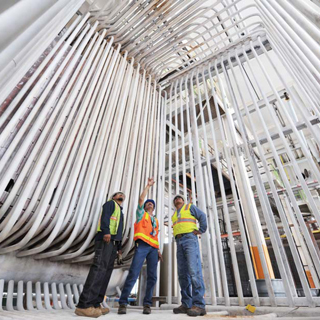
If operators didn’t hear the deafening sounds of heavy fans, motors, pumps, alarms, steam valves popping during testing, water running, and the hiss of steam moving through pipes, that meant something was wrong at Sandia’s steam plant, says Jerry Wright (4842-1), an electrician who worked there for 21 years.
Now, Bldg. 605 has fallen silent and by autumn it will no longer exist.
FINAL INSPECTION Bldg. 605 demolition team membersVincent Toya, left, Michael Pacheco, and Loren Sanchez inside thepipe framework of one of four boilers at Sandias 60-year-oldsteam plant. The water flowing through the pipes here washeated by the boiler and converted to steam, which was thenpiped to facilities all across the Labs. The central steam plant hasbeen replaced over the past several years with a system based ondistributed boilers. (Photo by Randy Montoya)
Officials from the Labs and NNSA celebrated on May 27 the completion of a modern distributed heating system and the start of demolition of the now-obsolete 18,000-square-foot steam plant that has been part of the Labs’ skyline for 60 years.
“It was a big part of my life for a long time,” says Jerry, who was the last Sandian to move out of the building in 2008. “It’s going to be strange to see it gone, but things change and you go on.”
The demolition of the obsolete facility marks the completion of the NNSA’s $60 million Heating System Modernization program at Sandia, which is part of NNSA’s Facilities and Infrastructure Recapitalization Program (FIRP). FIRP is aimed at eliminating or modernizing substandard facilities across the nation’s nuclear weapons enterprise and reducing a large maintenance backlog that developed during the 1990s.
The red brick building, which rises to four stories on its northern side, was designed by Black & Veatch of Kansas City, Mo., and the US Army Corps of Engineers in Albuquerque, according to records provided by corporate historian Rebecca Ullrich (9532). The plant also once heated the surrounding military base.
When the plant was first built, the operators lit the fires with a torch and monitored the flames by looking at them, Jerry says. Upgrades to that system came along in 1960 and 1994, he says. In its day, the plant was known for its efficiency. In 1960, during a cold snap its production reached a peak rate of water converted to steam per hour of more than 180,000 pounds, according to a Lab News article written that year.
At times, oil consumption reached nearly 35,000 gallons per day to heat the Laboratories and other facilities on the base, according to the Lab News article. Because the plant had to run around the clock, the operators were on call after regular work hours to respond to emergencies at the Labs, including intrusion alarms, fire alarms, vehicles stuck in winter snow storms, stuck elevators, and many others, Jerry says.
Heroes worked here, often unsung
“If anything, they were heroes. They kept this place warm and comfortable. They went out on calls at night, and sometimes they had no idea what was out there,” Jerry says.
Those who worked in the plant were proud that it could switch between fuel oil and natural gas, Jerry says. Sometimes during cold weather the local utility asked the Labs to switch so there would be enough fuel for Albuquerque hospitals and homes. At other times, the plant switched when fuel shortages arose to save money.
Deferred maintenance costs and equipment corrosion issues that made the steam plant inefficient led to a 2004 decision to replace the aging centralized heating system with local boilers placed in buildings or groups of buildings in Tech Area 1, which has now been completed, says Jim Smith, project manager of the Heating Systems Modernization effort.
“I love steam boilers. Any time you take something down, there’s always going to be that nostalgia, but by the same token it’s the right thing to do,” Jim says.
The new heating system will save nearly 12 million gallons of water a year. It is about 85 percent efficient, compared to the 65 percent efficiency rating for the old boilers. It will reduce heating system energy usage and pollutants by at least 60 percent, Jim says.
With the new heating system, emissions of nitrous oxides will be reduced from about 44 tons a year to nine tons a year. Carbon monoxide will decline from nearly 33 tons a year on the old system to 15.6 tons a year with the modern system. And, sulfur dioxide will fall from 14.5 tons a year to 0.4, Jim says.
“From a pollution standpoint, what we’re doing with the local boilers is way, way better,” he says.
About 80 percent of the work to modernize the heating system was completed by small businesses, one of which grew to become a large business while it was working on the project, Jim says. Over three years during the summers, these companies converted 47 buildings from the centralized system to local boilers. They installed 106 hot water boilers, five steam boilers, new natural gas connections, and meters, Jim says.
Sixty percent of the materials removed from buildings to prepare for the installation of the local boilers were recycled, he says. Significant additional recycling by the contractor is anticipated during the final demolition work.
The building will come down over the next six to eight weeks and all the debris, most of which will be recycled, should be removed from the site by the end of September, Jim says.